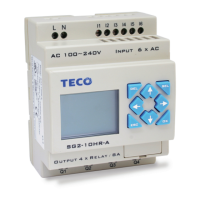Chapter 4 Relay Ladder Logic Programming 44
Chapter
4:
Relay
Ladder
Logic
Programming
Common Memory Types
General
output
SET
output
RESET
output
PULSE
output
N.O.
Contact
N.C.
Contact
Number
Symbol
[
¿
À
P (N.O. / N.C.)
Input
contact
I i 12 (I1-IC / i1-iC)
Keypad input
Z z 4(Z1-Z4 / z1-z4)
Output
coil
Q Q Q Q Q q 8 (Q1-Q8 / q1-q8)
Auxiliar
y
contact
M M M M M m 15 (M1-MF / m1-mF)
Counter
C
C c 15 (C1-CF / c1-cF)
T
i
mer
T
T T t 15 (T1-TF / t1-tF)
Inputs (I Memory Type)
The SG2 digital input points are designated I memory types. The number of digital I input points
are 6, 8, or 12 depending on each SG2 model.
Keypad Inputs (Z Memory Type)
The SG2 digital input points are designated Z memory types. The number of digital Z input points
are 4 depending on SG2 H type model.
Outputs (Q Memory Type)
The SG2 digital output points are designated Q memory types. The number of digital Q output
points is 4 or 8 depending on each SG2 model. In this example, output point Q1 will be turned on
when input I1 activated.
Auxiliary Relays (M Memory Type)
Auxiliary relays are digital internal memory bits used to control a ladder logic program.
The auxiliary relays are not physical inputs or outputs that can be wired to any external device;
switches, sensors, relays, lamps, etc.
Since auxiliary relays are internal bits within the CPU, they can be programmed as digital inputs
(contacts) or digital outputs (coils). In the first rung of this example, auxiliary relay M1 is being
used as an output coil and will energize when input I2 turns on. In the second rung auxiliary relay
M1 is being used as an input and when energized, will turn on outputs Q2 and Q3.

